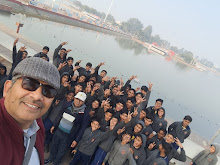WHATEVER YOUR STRENGTH POLISH IT AND TAKE IT TO NEW ..."MUKAAM."
AS .Mr R K LAXMAN...
AS .Mr R K LAXMAN...
NEW DELHI: RK Laxman was born in Mysore. His
father was a headmaster and Laxman was the youngest of six sons. His older
brother is the famous novelist R K Narayan.
Laxman was engrossed by the illustrations in
magazines such as The Strand Magazine, Punch, Bystander, Wide World and
Tit-Bits, even before he could read. Soon he was drawing on his own, on the
floors, walls and doors of his house and doodling caricatures of his teachers
at school. Praised by a teacher for his drawing of a peepal leaf, he began to
think of himself as an artist in the making.
(Times of India.)
1.
Rasipuram
Krishnaswami Laxman was an Indian cartoonist, illustrator, and humorist. He is
best known for his creation The Common Man and for his daily cartoon strip,
"You Said It" in The Times of India, which started in 1951.Wikipedia
4. Spouse: Kamala Laxman



.jpg)
























